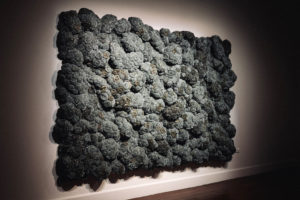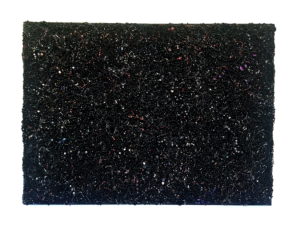We’re all lunatics now
Hot. Very hot. I sway into Dani Marti’s exhibition Black Sun at Fremantle Arts Centre.
In Gallery 3, the work Time inhabits the room like a living thing – a stromatolite reef seen from above through clear water, light catching and flashing at the edges of its spongey buddings and puffed anemone-like clusters. The grey and bronze form seems to come from an aeon before primary colours. I feel suspended, as though looking down at the earth’s first living layer. But these mounds are actually made of thick clumps of galvanised and stainless steel kitchen scourers, and despite their ancient, organic appearance, their repetition and accretion also suggests obsessive industrial consumerism, and to me at least, the endless domestic work of women.
A reef created from the discarded tools of countless, nameless cleaning women. I don’t remember the last time I felt so splayed between awe and irony.
And I’m not suggesting that Dani Marti had any of these things – stromatolites, polyps, the image of women scouring the earth – in mind when he made Time. It doesn’t matter. The work he has made in this resonant space is so generous and tender and ambiguous, so work he has made in this resonant space is so generous and tender and ambiguous, so porous to its context, that it seems capable of encompassing everything, including the laughter, shrieks and silences of the women who were once incarcerated in this room.
 Dani Marti, Time, 2013. Galvanised and stainless steel scourers on aluminium frame (detail)
Dani Marti, Time, 2013. Galvanised and stainless steel scourers on aluminium frame (detail)
The pamphlet in my hand tells me Gallery 3 was once a maternity ward for the discarded women of Perth, in a building erected as a lunatic asylum (for both sexes) in the fledgling settlement, and later used as a women’s home and ‘maternity training school’ throughout the first half of the 20th century.
The most powerful performance work I’ve ever seen, Louise Lowe and Anù Productions’ Laundry (2011), took place in Dublin’s Magdalene Laundry, a building similarly (shamefully recently, in Dublin’s case) set aside for the enclosure and social obliteration of the ‘deviant’, deranged and despairing of the tender sex. Walking the glowing jarrah corridors of the Fremantle Arts Centre into room after room suffused with light and the beautiful profusion of materials in Marti’s work, there’s none of the institutional bleakness and emotional dereliction that Lowe’s work drew out of the stained walls of the Dublin building, but somewhere in the distance, even here, there’s the faint smell of carbolic soap.
It makes even more beautiful and poignant Marti’s Mother series of large-scale frames filled with countless coloured beads and necklaces – thick constellations of second-hand (or second-throat) trinkets gathered over many years. The series speaks of extreme intimacy (Marti has said he could sometimes still smell a trace of former owners in the jewellery), luxury (each work the surface layer of an apparently bottomless treasure chest in which the value of individual objects is overwhelmed by abundance), and loss (especially the composition in black and blue, with its predominance of funereal black beads). These works too seem to come from the sea floor, to belong to a world of proud and mad women, submerged beneath a decorative femininity.

Mother (composition in black and blue), 2024-2015. Necklaces and beads on powder- coated aluminium frame (detail)
Stromatolite comes from the Ancient Greek for bed, or layer. The city lies on a bed of sand and white limestone – the memory of the sea and of life’s flux. Perhaps a thousand generations of Noongar people have moved across this coastal plain before and since these buildings went up. Histories surface here unexpectedly, everywhere, and are immanent in things. The Arts Centre was once a place of beds and white linen, of moral proprieties, punishment and restraint. The concrete sofa in the forecourt hints at padded cells, and also emphasises the contrast between the idea of home and the reality of emotional, social and physical displacement. It was perhaps too, at times, a place of refuge and community, or at least consistency as a bulwark against chaos.
Many of the behaviours once described as lunatic which led to so much stigmatism and shame, today might point instead to the original, wayward and awkward – to artists and to outsiders, to the eccentric and rebellious as well as the haunted and dispossessed. It’s a mad, mad world, and we’re all lunatics now, looking for grace in cool water and connection, in artworks, song and story that restore some form of coherence to our landscapes. Crossing Fremantle Bridge on my way to the water, I look down on a work of landscapes. Crossing Fremantle Bridge on my way to the water, I look down on a work of submerged spiritual graffiti. It’s as though someone has taken Dani Marti’s kitchen stromatolites, his clumps and clusters of beads, and returned them to their first home in the sea. And over millennia, they’ve organised themselves into a single word. I’m not sure at all any more where lives, beliefs, landscapes and works of art begin or end, but I suspect, and hope, it may be here.
Ruth Little